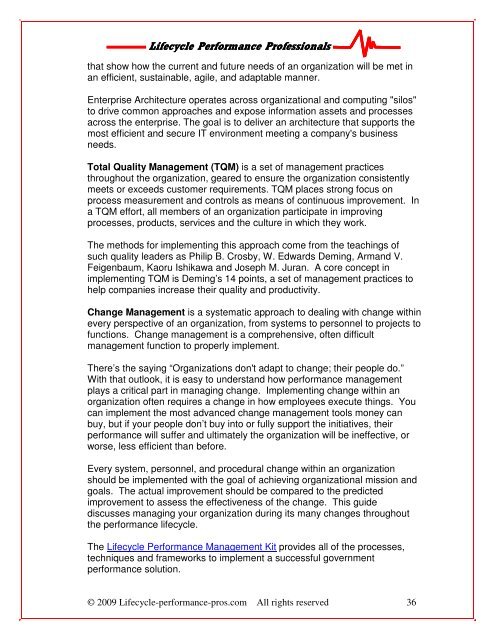Download the Performance Management Fundamentals Guide
Download the Performance Management Fundamentals Guide
Download the Performance Management Fundamentals Guide
Create successful ePaper yourself
Turn your PDF publications into a flip-book with our unique Google optimized e-Paper software.
Lifecycle Lifecycle <strong>Performance</strong> <strong>Performance</strong> Professionals<br />
Professionals<br />
that show how <strong>the</strong> current and future needs of an organization will be met in<br />
an efficient, sustainable, agile, and adaptable manner.<br />
Enterprise Architecture operates across organizational and computing "silos"<br />
to drive common approaches and expose information assets and processes<br />
across <strong>the</strong> enterprise. The goal is to deliver an architecture that supports <strong>the</strong><br />
most efficient and secure IT environment meeting a company's business<br />
needs.<br />
Total Quality <strong>Management</strong> (TQM) is a set of management practices<br />
throughout <strong>the</strong> organization, geared to ensure <strong>the</strong> organization consistently<br />
meets or exceeds customer requirements. TQM places strong focus on<br />
process measurement and controls as means of continuous improvement. In<br />
a TQM effort, all members of an organization participate in improving<br />
processes, products, services and <strong>the</strong> culture in which <strong>the</strong>y work.<br />
The methods for implementing this approach come from <strong>the</strong> teachings of<br />
such quality leaders as Philip B. Crosby, W. Edwards Deming, Armand V.<br />
Feigenbaum, Kaoru Ishikawa and Joseph M. Juran. A core concept in<br />
implementing TQM is Deming’s 14 points, a set of management practices to<br />
help companies increase <strong>the</strong>ir quality and productivity.<br />
Change <strong>Management</strong> is a systematic approach to dealing with change within<br />
every perspective of an organization, from systems to personnel to projects to<br />
functions. Change management is a comprehensive, often difficult<br />
management function to properly implement.<br />
There’s <strong>the</strong> saying “Organizations don't adapt to change; <strong>the</strong>ir people do.”<br />
With that outlook, it is easy to understand how performance management<br />
plays a critical part in managing change. Implementing change within an<br />
organization often requires a change in how employees execute things. You<br />
can implement <strong>the</strong> most advanced change management tools money can<br />
buy, but if your people don’t buy into or fully support <strong>the</strong> initiatives, <strong>the</strong>ir<br />
performance will suffer and ultimately <strong>the</strong> organization will be ineffective, or<br />
worse, less efficient than before.<br />
Every system, personnel, and procedural change within an organization<br />
should be implemented with <strong>the</strong> goal of achieving organizational mission and<br />
goals. The actual improvement should be compared to <strong>the</strong> predicted<br />
improvement to assess <strong>the</strong> effectiveness of <strong>the</strong> change. This guide<br />
discusses managing your organization during its many changes throughout<br />
<strong>the</strong> performance lifecycle.<br />
The Lifecycle <strong>Performance</strong> <strong>Management</strong> Kit provides all of <strong>the</strong> processes,<br />
techniques and frameworks to implement a successful government<br />
performance solution.<br />
© 2009 Lifecycle-performance-pros.com All rights reserved 36










